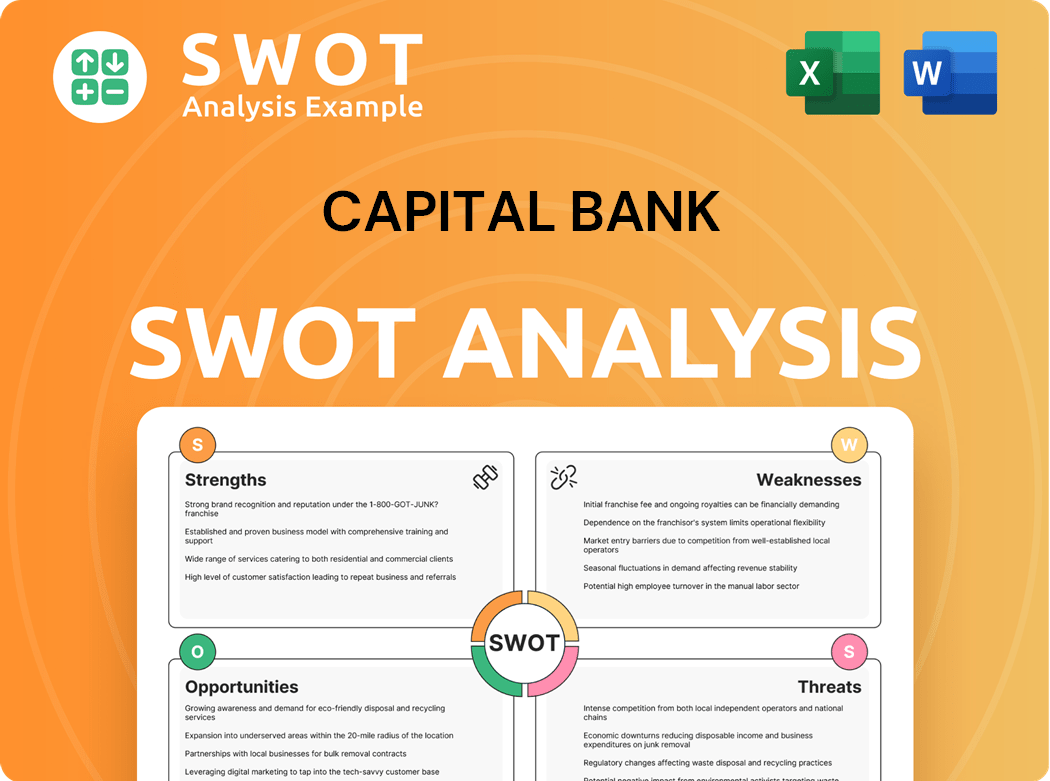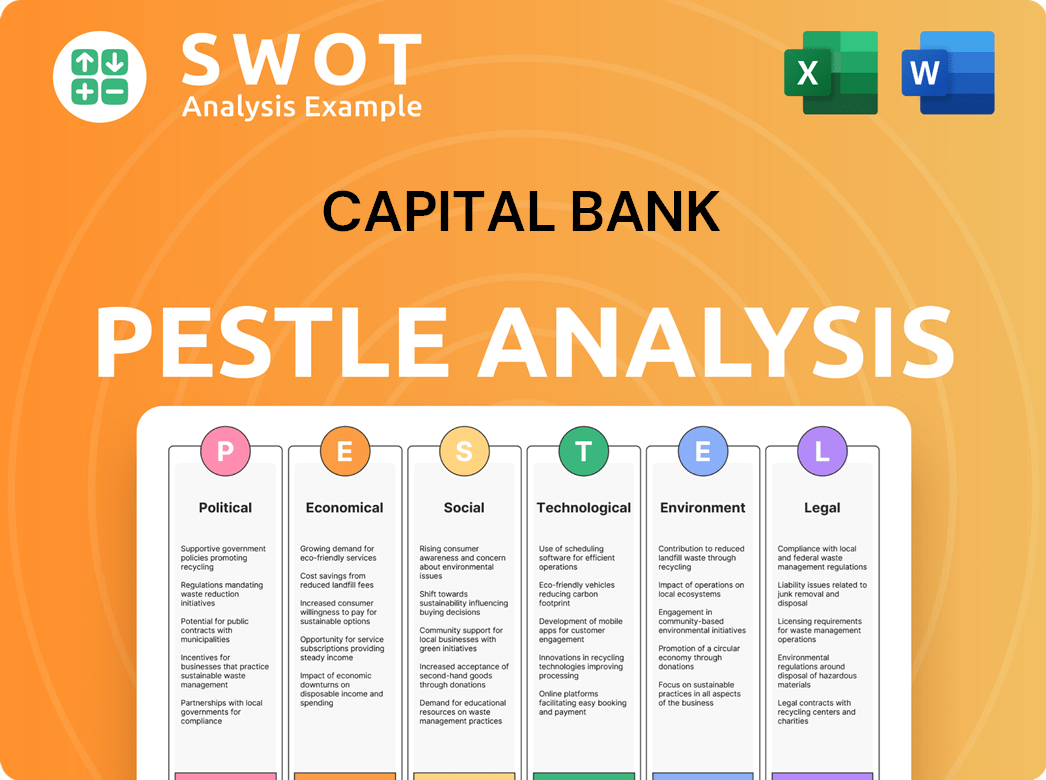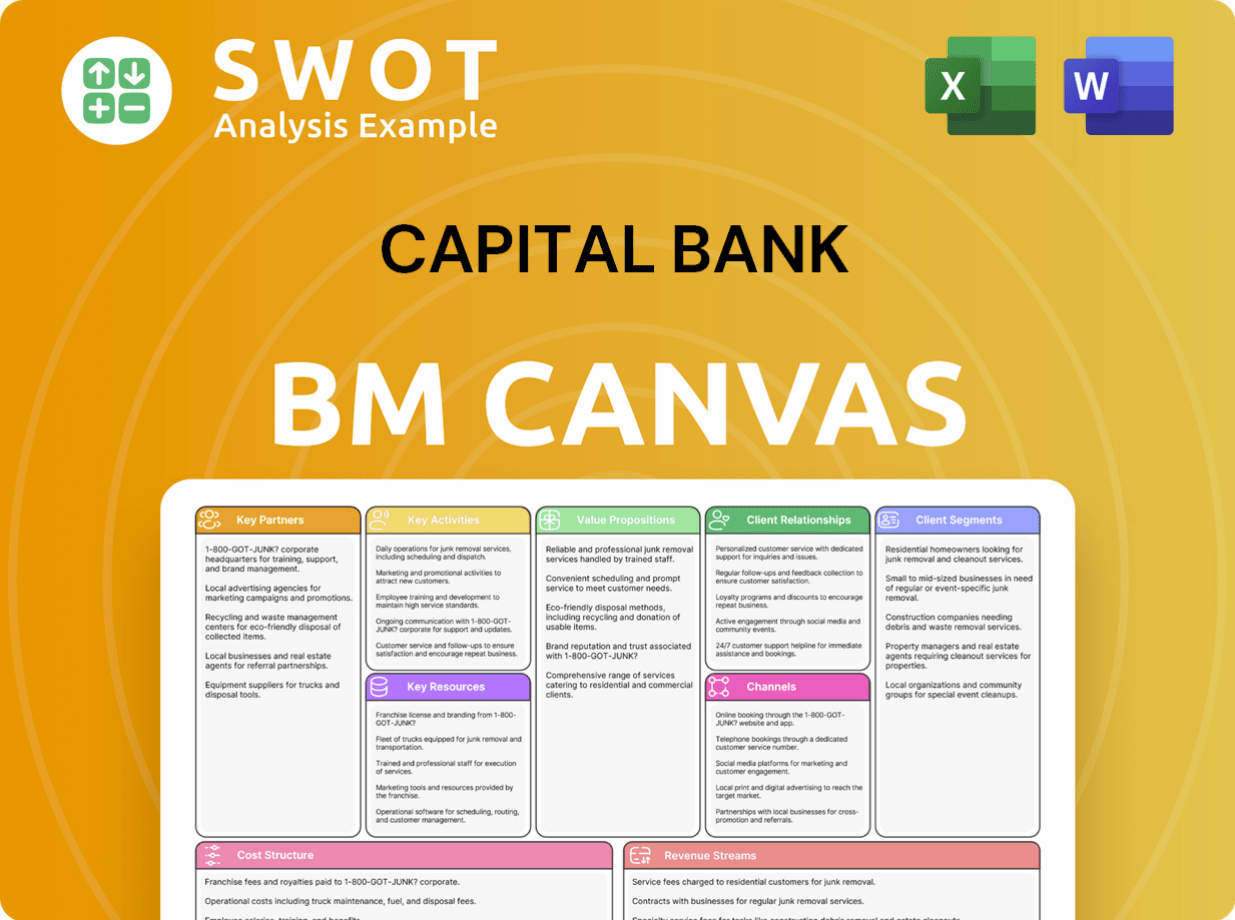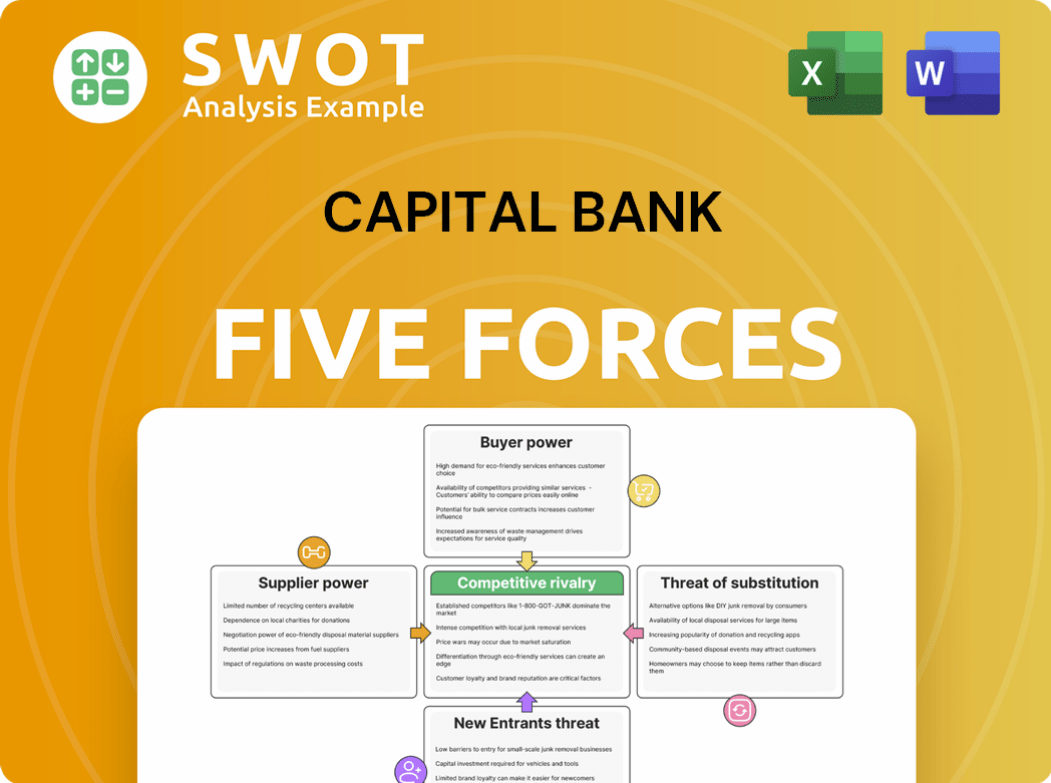Capital Bank Bundle
Who Are Capital Bank's Customers?
In the ever-evolving world of finance, knowing your customer is key, and for Capital Bank, understanding its Capital Bank SWOT Analysis is crucial. Capital Bank's impressive financial performance, including a 50% profit surge in 2024, highlights the importance of pinpointing the right audience. This success story begs the question: who exactly is Capital Bank targeting, and how are they reaching them?

This exploration delves into the Capital Bank customer profile, examining their customer demographics and strategic focus. We'll analyze the bank's Capital Bank target market, considering its evolution from serving large enterprises to embracing digital services for retail clients. Understanding the banking customer segmentation and financial institution audience will reveal how Capital Bank aims to meet the diverse needs of its Capital Bank client base, offering actionable insights for investors and strategists alike.
Who Are Capital Bank’s Main Customers?
Understanding the customer demographics and target market of Capital Bank involves analyzing its diverse operations across different geographic regions and business lines. The bank serves both individual consumers (B2C) and businesses (B2B), with a strategic focus that varies depending on the region. This segmentation is crucial for tailoring products, services, and marketing efforts to meet specific customer needs and preferences. Analyzing the Competitors Landscape of Capital Bank provides additional context for understanding its market position.
In the U.S., Capital Bancorp, Inc. highlights a strong B2B presence. As of December 31, 2024, commercial and industrial loans made up 21.0% of total gross loans, amounting to $554.6 million. Simultaneously, the company's digitally-enabled consumer-direct product accounts for roughly 10% of its origination volume, indicating a significant B2C presence. The acquisition of IFH in October 2024 and its operational integration in February 2025 expanded its customer base further.
Capital Bank Group, operating in Jordan and the surrounding region, has expanded its retail banking market, particularly through its digital bank, Blink, launched in 2022. This strategic move targets mobile phone users, indicating a focus on a tech-savvy demographic. The National Bank of Iraq, a subsidiary, serves both individual and corporate customers, with the group's overall customer base growing by over 30,000 new clients in the first half of 2023, reaching 585,966 customers. This growth reflects its customer acquisition strategies.
The primary customer segments in the U.S. include businesses through commercial and industrial loans and consumers via its digital products. The bank's focus on both B2B and B2C segments allows it to serve a broad range of financial needs. The acquisition of IFH further broadened its customer base.
In Jordan and Iraq, the focus is on expanding the retail banking market, particularly through the digital bank, Blink. This targets mobile users, suggesting a younger, tech-savvy demographic. National Bank of Iraq serves individual and corporate clients, contributing to overall customer growth.
Capital Bank employs customer segmentation strategies to tailor its products and services. In the U.S., the bank focuses on both businesses and consumers, while in Jordan and Iraq, the emphasis is on digital banking to attract a tech-savvy audience. These strategies help Capital Bank meet the diverse needs of its customer base.
Strategic acquisitions such as IFH in the U.S., and Bank Audi's operations in Jordan and Iraq, and Société Générale Bank's branches in Jordan have strengthened Capital Bank's market position. These acquisitions have diversified its customer segments. These acquisitions have expanded its customer base.
Capital Bank's primary customer segments are diverse, encompassing both businesses and consumers across different geographic locations. The bank's focus on digital banking in Jordan and Iraq suggests an appeal to a tech-savvy demographic, while the U.S. operations cater to both commercial and consumer needs. Understanding the customer demographics is essential for effective market analysis.
- Businesses: Served through commercial and industrial loans, particularly in the U.S.
- Consumers: Targeted through digital banking platforms like Blink and consumer-direct products.
- Tech-Savvy Individuals: Targeted in Jordan and Iraq through digital banking solutions.
- Corporate Clients: Served by the National Bank of Iraq.
Capital Bank SWOT Analysis
- Complete SWOT Breakdown
- Fully Customizable
- Editable in Excel & Word
- Professional Formatting
- Investor-Ready Format

What Do Capital Bank’s Customers Want?
Understanding customer needs and preferences is crucial for the success of any financial institution. For the entity in question, this involves a deep dive into the local community it serves, focusing on building lasting relationships. The company's offerings, including checking and savings accounts, loans, and mortgages, are designed to meet a broad spectrum of financial needs.
The modern banking customer increasingly values convenience, personalized experiences, and efficient digital solutions. This shift necessitates a proactive approach to technology and service delivery. The company's recent launch of a new digital banking platform, powered by Q2 in May 2025, exemplifies this commitment to providing a secure, modern experience and fostering customer-focused growth.
In the broader banking landscape, customer pain points and unmet needs drive effective marketing and product development. This includes conducting user research, analyzing customer feedback, and iterating on product designs to address challenges. For example, banks are focusing on offering diversified services and personalized assistance to enhance customer retention.
Customers increasingly prefer digital interactions. The new platform is designed to meet this demand. This shift is evident in the broader industry trends.
Customers expect personalized services. Banks are focusing on tailored solutions. This includes offering services based on individual needs.
Convenience is a key driver of customer satisfaction. Digital platforms enhance efficiency. The company's initiatives reflect this.
Banks are addressing customer pain points. This includes simplifying complex processes. Personalized advice is becoming more common.
Financial institutions are investing in technology. This includes AI solutions. These advancements improve customer experience.
Retention is a key focus for banks. Offering diversified services is crucial. Cross-selling and upselling based on needs are common.
To cater to the Capital Bank customer profile, the company likely considers several factors. These include the customer demographics, such as age, income levels, and location, which inform the design of financial products. The Capital Bank target market analysis would also encompass customer behavior, including how customers interact with digital platforms and their expectations for Capital Bank customer service expectations. Understanding these aspects helps the company tailor its services and Capital Bank customer acquisition strategies to effectively reach and retain its client base. The company's approach to banking customer segmentation and its understanding of the financial institution audience are crucial for success. The goal is to maximize Capital Bank customer lifetime value by meeting their Capital Bank customer needs and preferences.
The company focuses on meeting customer needs. This involves providing convenient and personalized services. Understanding customer behavior is key.
- Convenience: Digital platforms and easy-to-use interfaces are essential.
- Personalization: Tailored financial products and services based on individual needs.
- Security: Robust security measures to protect customer data and transactions.
- Efficiency: Streamlined processes and quick access to information.
- Support: Excellent customer service and readily available assistance.
Capital Bank PESTLE Analysis
- Covers All 6 PESTLE Categories
- No Research Needed – Save Hours of Work
- Built by Experts, Trusted by Consultants
- Instant Download, Ready to Use
- 100% Editable, Fully Customizable

Where does Capital Bank operate?
The geographical market presence of Capital Bank is multifaceted, varying significantly depending on the specific entity and the services offered. Capital Bank, N.A., primarily serves the Washington D.C. metropolitan area, while its lending brands, Capital Bank Home Loans and OpenSky, have a nationwide reach across all 50 states. This dual approach allows the institution to cater to both local and national customer demographics.
Capital Bank Group, based in Amman, Jordan, focuses on a regional footprint, offering commercial and investment banking services in Jordan, Iraq, the UAE, and Saudi Arabia. This strategic positioning allows the group to capitalize on the economic dynamics of the Middle East. The National Bank of Iraq (NBI), a subsidiary of Capital Bank Group, has expanded effectively within the Iraqi market.
In May 2025, Capital Bancorp announced an expansion of its Commercial Banking operations in Delaware, highlighting its commitment to strengthening its presence in the Mid-Atlantic region. This expansion aligns with its strategy to broaden its customer base and service offerings. This expansion is a key element of its growth strategy, targeting specific Revenue Streams & Business Model of Capital Bank.
Capital Bank, N.A., concentrates on the Washington D.C. metropolitan area, providing tailored financial solutions to local customers. This localized approach allows for a deeper understanding of local market needs and preferences. Capital Bank Home Loans and OpenSky extend services nationwide, broadening the customer base.
Capital Bank Group operates in Jordan, Iraq, the UAE, and Saudi Arabia, leveraging regional economic opportunities. The National Bank of Iraq (NBI) has shown significant growth within Iraq. The group's strategic expansion aims to establish a strong presence in Saudi Arabia and the UAE, enhancing its regional influence.
The expansion of Commercial Banking operations in Delaware marks a strategic move to strengthen Capital Bank's presence in the Mid-Atlantic region. This expansion is designed to attract new customers and increase market share. This expansion is a key element of its growth strategy, targeting specific customer demographics.
In Jordan, Capital Bank Group holds an 8.9% market share of Jordanian market deposits. It has been recognized as the fastest-growing bank since 2020. The bank's total assets grew by 8.5% at the end of 2024, reaching JOD 8.2 billion, and customer deposits increased by 8% to JOD 5.9 billion.
Capital Bank Business Model Canvas
- Complete 9-Block Business Model Canvas
- Effortlessly Communicate Your Business Strategy
- Investor-Ready BMC Format
- 100% Editable and Customizable
- Clear and Structured Layout

How Does Capital Bank Win & Keep Customers?
Customer acquisition and retention strategies are crucial for the success of any financial institution. These strategies are particularly important for institutions like the Capital Bank, which must continually evolve to meet the changing needs of its target market. Understanding the customer demographics and the institution's customer profile is essential to develop effective strategies. This involves leveraging digital channels, personalizing customer interactions, and continuously improving service quality.
In 2024 and 2025, the financial sector is seeing a significant shift towards digital transformation. Banks are investing in advanced digital services to improve customer experience and expand their user base. The focus is on creating seamless, user-friendly experiences across all touchpoints. This includes mobile banking apps, online platforms, and digital payment solutions. Banks also use data analytics and AI to personalize customer interactions and improve operational efficiency.
Customer retention is a key factor in profitability. Banks are focusing on building strong customer relationships and offering diversified services. The industry average retention rate hovers around 75%. Customer relationship management (CRM) systems are crucial for managing customer data and segmenting marketing campaigns effectively. Institutions that prioritize customer needs and provide excellent service are more likely to retain their clients.
The launch of a new digital banking platform in partnership with Q2 in May 2025, is a prime example of digital transformation. This provides a modern and secure experience for business customers. This indicates an emphasis on digital transformation to attract and serve a digitally-savvy clientele.
Banks are increasingly focusing on omnichannel and multichannel marketing strategies. This includes digital advertising, content marketing, and personalized outreach. This approach increases visibility and provides proper communication channels for potential customers, enhancing customer acquisition efforts.
Investment in enhancing financial technologies and providing advanced digital services significantly improves customer experience. The implementation of AI solutions enhances banking services and improves operational efficiency. This approach can lead to a stronger customer base and greater customer satisfaction.
Commitment to service excellence and customer-centric solutions is a core strategy for banks. Building strong customer relationships is a cornerstone for retention in the banking industry. This approach leads to growth in the client base and enhances customer loyalty.
To understand the specific strategies of the Capital Bank, it's useful to look at the broader financial landscape. The Growth Strategy of Capital Bank provides insights into the bank's approach. Banks are increasingly focusing on personalized services, such as tailored financial advice, to meet the diverse needs of their customer base. They also use data analytics to understand customer behavior and preferences better. Furthermore, customer service expectations are rising, with customers demanding quick and efficient solutions to their banking needs.
Banks are using digital advertising, content marketing, and personalized outreach to increase visibility. They are also focusing on community engagement and leveraging social media. These strategies aim to attract new customers by providing relevant information and building trust.
Offering diversified services, personalized assistance, and upsell opportunities are key. Building strong customer relationships and acting on customer feedback are also crucial. These tactics aim to foster loyalty and reduce customer churn.
Banks use customer data to segment their audience and tailor marketing campaigns. This segmentation helps them target specific customer demographics and offer products that meet their needs. Data analytics is crucial for this process.
Understanding the customer profile is essential for effective strategies. This includes knowing their age, income levels, location, and financial needs. Banks use this information to create ideal customer profiles and tailor their services.
The Capital Bank client base likely includes a mix of individuals and businesses. The bank's focus on digital transformation suggests a target market that is comfortable with technology. Understanding the specific needs of this client base is crucial.
Customers expect quick and efficient solutions to their banking needs. Banks must provide excellent customer service to retain clients. This includes offering multiple channels for communication and resolving issues promptly.
Capital Bank Porter's Five Forces Analysis
- Covers All 5 Competitive Forces in Detail
- Structured for Consultants, Students, and Founders
- 100% Editable in Microsoft Word & Excel
- Instant Digital Download – Use Immediately
- Compatible with Mac & PC – Fully Unlocked

Related Blogs
- What are Mission Vision & Core Values of Capital Bank Company?
- What is Competitive Landscape of Capital Bank Company?
- What is Growth Strategy and Future Prospects of Capital Bank Company?
- How Does Capital Bank Company Work?
- What is Sales and Marketing Strategy of Capital Bank Company?
- What is Brief History of Capital Bank Company?
- Who Owns Capital Bank Company?
Disclaimer
All information, articles, and product details provided on this website are for general informational and educational purposes only. We do not claim any ownership over, nor do we intend to infringe upon, any trademarks, copyrights, logos, brand names, or other intellectual property mentioned or depicted on this site. Such intellectual property remains the property of its respective owners, and any references here are made solely for identification or informational purposes, without implying any affiliation, endorsement, or partnership.
We make no representations or warranties, express or implied, regarding the accuracy, completeness, or suitability of any content or products presented. Nothing on this website should be construed as legal, tax, investment, financial, medical, or other professional advice. In addition, no part of this site—including articles or product references—constitutes a solicitation, recommendation, endorsement, advertisement, or offer to buy or sell any securities, franchises, or other financial instruments, particularly in jurisdictions where such activity would be unlawful.
All content is of a general nature and may not address the specific circumstances of any individual or entity. It is not a substitute for professional advice or services. Any actions you take based on the information provided here are strictly at your own risk. You accept full responsibility for any decisions or outcomes arising from your use of this website and agree to release us from any liability in connection with your use of, or reliance upon, the content or products found herein.